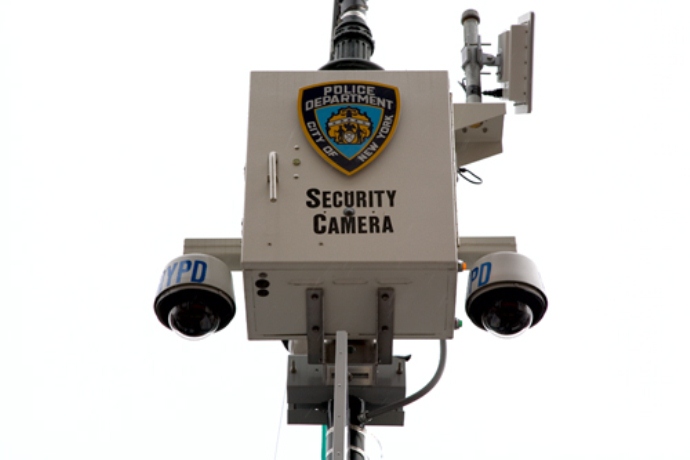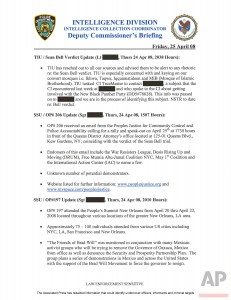
(MintPress) – An Associated Press (AP) investigation has revealed new surveillance tactics separate from those used on Muslims by the New York Police Department (NYPD) on various liberal political organizations to keep logs on planned protests around the country. The report brings to focus how police have used spying tactics on other organizations in the past and echoes historical comparisons to a Federal Bureau of Investigation (FBI) program implemented up until 1971 to spy on political organizations.
The report details one instance where an undercover NYPD officer travelled to New Orleans to attend the People’s Summit – an event where groups speak about political, economic and social issues facing the world. The officer took note of the speakers, locations of upcoming rallies and the issues the groups were demonstrating for or against. The officer reported back to the Intelligence Division of the NYPD with a wide array of details, one of which was:
“May Day (May 1, 2008) rallies will be held in the following cities across the United States: San Francisco, Los Angeles, Chicago, Miami, Boston and New York City. The rally in New York City will take place from 1200 to 1600 hours at Union Square. The rally will focus on an end to the ICE deportations of immigrant families, workplace raids taking place across the United States and the Anti-war movement.”
The NYPD has said the spying is a necessary tool that allows the department to plan more in advance for huge crowds of protesters. But the surveillance has taken place over the course of years, with the NYPD using infiltration tactics to report back on anti-war organizations and environmental groups who were planning protests during the 2004 Republican National Convention.
But the NYPD says political affiliation has nothing to do with their mission to get a leg-up on demonstrations. Peaceful protests have, in the past, turned into violent riots. The AP cites instances in Cincinnati in 2001 and Toledo in 2005 that produced some of the largest urban disruptions in the country.
David Cohen, the top intelligence officer for the NYPD, testified during a lawsuit against the NYPD based on its treatment of protesters during the Republican National Convention that the department targets groups that could potentially be unlawful, and not just groups with particular political affiliations.
“There was no political surveillance,” Cohen testified. “This was a program designed to determine in advance the likelihood of unlawful activity or acts of violence.”
NYPD police commissioner Raymond Kelly told the AP that everything the department is doing is legal on the grounds of protecting public safety and planning ahead to organize officer presence at demonstrations. The surveillance has yet to be challenged in a United States court.
The American Civil Liberties Union (ACLU) studied state law enforcement and its role in spying on activist groups across the country. The ACLU found that 36 states plus the District of Columbia used law enforcement to monitor activities of political activist groups.
“Law enforcement agencies across America continue to monitor and harass groups and individuals for doing little more than peacefully exercising their First Amendment rights,” the ACLU wrote.
One protester who was present at the People’s Summit was less worried about the legalities of the spying and more concerned about their first-amendment right to protest being limited. Eugene Puryear told the AP that the NYPD saw the demonstrations as a threat to their policing practices.
“From their perspective, they need to spy on peaceful groups so they’re not effective at putting out their peaceful message,” Puryear said. “They are threatened by anything challenging the status quo.”
‘Status quo’
The “same old, same old” for protest groups has been an uphill battle for some. As of last year, the Occupy movement in New York has often been at odds with the NYPD – facing evictions from parks, arrests and sometimes incidents of violence.
Recently, reports said the NYPD used violent force on a peaceful protest in Zuccotti Park because officers claimed the demonstrators were there after the park had closed. Another recent incident involved a tense clash between the NYPD and Occupy protesters that resulted in at least one protester being taken away on a stretcher.
As a result, demonstrators marched in New York City against police violence and to call for the resignation of NYPD commissioner Ray Kelly. The protesters had harsh words for the NYPD leadership, and even had a city councilman Jumaane Williams speaking in favor of the movement.
“I don’t blame the rank and file NYPD. I blame the leadership of the NYPD and the city,” Williams went on to say. “When you try to suppress people’s speech, they do tend to get angry. What I saw last week was people using Zuccotti park in the way that it was supposed to be, the way that they were told that they could legally use it and they still got beat up and they still got arrested.”
Occupy protester Aaron Black told The Guardian that the NYPD had been quelling their voice from the get-go.
“We started the conversation in September,” Black said. “What we’re upset about is that they keep interrupting the conversation.”
“We keep getting our heads kicked,” he added. “That’s not constitutional.”
A petition has been organized that calls for investigations into NYPD violence against Occupy Wall Street protesters. The petition says “The Department seems to be actively attempting to suppress the nonviolent movement through infiltration, monitoring and violent arrest.”
The NYPD also has come under fire for monitoring Muslim businesses, mosques, and Muslim students on college campuses to get a better understanding of the communities and to prevent the organizing of potential terrorist attacks. The NYPD called the tactics legal and necessary, but many disagree.
Civil rights lawyers say some of the practices were most likely legal, but some not. Monitoring internet site activity was legal, according to the lawyers, but when the NYPD was keeping police files on religious sermons, they were breaking the law.
The issue of racial profiling in this matter speaks to the broad spectrum of surveillance, as laws are often vaguely written, making it difficult to apply them to individual cases. New York City prohibits racial profiling, but the vague law does not conclude what a “determinative factor” of racial profiling is.
COINTELPRO/Operation CHAOS
The NYPD has currently limited its tactics to infiltration and espionage, according to the report. But history has shown large-scale surveillance tactics taken to greater levels that involve the FBI and Central Intelligence Agency (CIA).
Surveillance operations have deep roots in the U.S., particularly with the FBI’s infiltration of political organizations between 1956 and 1971 with its Counter Intelligence Program (COINTELPRO). The operation was started in order to “disrupt” and “neutralize” particular groups and individuals that were deemed threats to domestic safety.
The covert action was aimed at five particular groups: the “Communist Party, USA”; the “Socialist Workers Party; the “White Hate Group”; the “Black Nationalist-Hate Group”; and the “New Left.”
Once the FBI had infiltrated the groups, they used tactics to undermine their success; they planted false media stories about the groups, forged letters on their behalf and sometimes break into homes illegally to intimidate participants in the movement so they would not continue.
Once the program was exposed by a journalist in 1971, the operation was officially halted. Many of the tactics, however, did not stop. In the name of “counterterrorism,” then-president Ronald Reagan issued national security guidelines that many criticize as allowing for COINTELPRO to unofficially continue.
TheCIA conducted domestic espionage projects under the name Operation CHAOS from 1967-1973 with the goal of exposing foreign influence and resources within anti-war movements during that time. Targets of the monitoring were “Students for a Democratic Society,” “Black Panther Party,” “Women Strike for Peace” and Ramparts Magazine, a political publication that ended in 1975.
The CIA feared the protesters and “foreign elements” were in contact because they had similar anti-war motives and mutual interests. Initial investigations revealed “no evidence of any contact between the most prominent peace movement leaders and foreign embassies in the U.S. or abroad,” but the surveillance continued.
Upon its collapse shortly after the Watergate scandal, George H. W. Bush admitted that portions of the operation were illegal and that the CIA had obtained information that it did not have access to.
“The operation in practice resulted in some improper accumulation of material on legitimate domestic activities,” Bush said.
Source: MintPress


